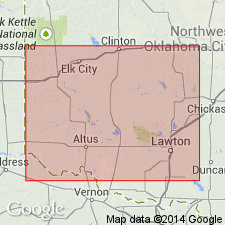
- Usage in publication:
-
- Elm Fork Member
- Modifications:
-
- First used
- Dominant lithology:
-
- Gypsum
- Dolomite
- Shale
- AAPG geologic province:
-
- Palo Duro basin
- Anadarko basin
- South Oklahoma folded belt
Summary:
First published use of name as the lower member of the Blaine Formation of El Reno Group. Was named in an unpublished thesis by same author in 1967. Type section measured in E1/2 SW1/4 sec 11, T6N, R26W, in escarpment 300 ft east of Kiser salt plain, Harmon Co, OK in the Palo Duro basin. Total measured thickness at type is 81.9 ft where it is divisible into (ascending) Haystack Gypsum Bed, unnamed beds, Jester Dolomite Bed, Cedartop Gypsum Bed, unnamed beds, Creta Dolomite Bed, Collingsworth Gypsum Bed, and unnamed beds. Haystack, Jester, Cedartop, Creta, Collingsworth were formerly members of Blaine. At type, overlies Flowerpot [Flower-pot] Shale and underlies Van Vacter Member (revised), upper member of Blaine. Ranges from 70 to 140 ft thick; commonly is 90-110 ft thick. Cross sections. In a measured section in NW1/4 SW1/4 sec 23, T1S, R22W, Gypsum Creek Dolomite Bed (first published), which underlies Haystack Bed, is the oldest unit of Elm Fork. The gypsums are white, finely crystalline. The dolomites are gray, finely crystalline, oolitic. The unnamed shales are green to red brown. Sections measured in Harmon and Jackson Co (Palo Duro basin), Beckham Co (Anadarko basin), and Greer Co (S. Oklahoma folded belt province). Permian age.
Source: GNU records (USGS DDS-6; Denver GNULEX).
For more information, please contact Nancy Stamm, Geologic Names Committee Secretary.
Asterisk (*) indicates published by U.S. Geological Survey authors.
"No current usage" (†) implies that a name has been abandoned or has fallen into disuse. Former usage and, if known, replacement name given in parentheses ( ).
Slash (/) indicates name conflicts with nomenclatural guidelines (CSN, 1933; ACSN, 1961, 1970; NACSN, 1983, 2005, 2021). May be explained within brackets ([ ]).

